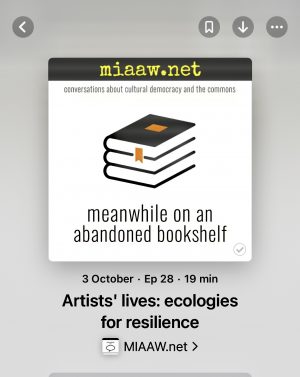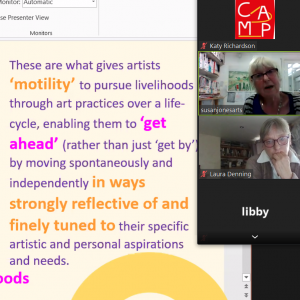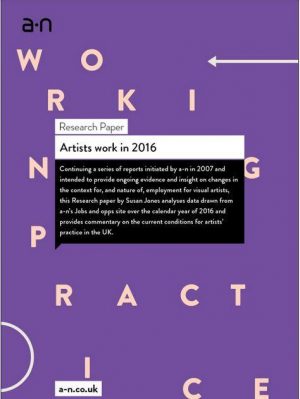Owen Kelly critiques Artists’ lives: ecologies for resilience in a MIAAW podcast. In particular, he considers the efficacy and social resonance of the study’s research methodology which — unusually for the arts — is qualitative and longitudinal. He judges its value as provision of a unique and detailed examination of the kind of lives artists live when culture is seen politically as an industry rather than as a social responsibility.
Read “Artists' lives - the arts policy fallacy” in full
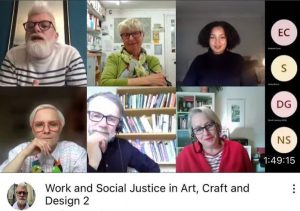
Panel screenshot 26 April 2022
‘Work and Social Justice in Art, Craft and Design’ with Dani Child, David Hesmondhalgh, Kylie Jarratt, Susan Jones and Jade Monserrat, convened by Dave Beech, Reader in Art and Marxism, University of the Arts London.
Read “Work and Social Justice in Art, Craft and Design” in full
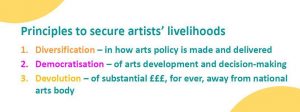
This submission was made in June 2020 to the DCMS Committee considering the impact of Covid-19 on any sectors under the Department for Digital, Culture, Media and Sport’s remit. It contextualises artists’ livelihood frameworks and sectoral artistic and economic opportunity, highlighting key challenges and barriers faced by this particular sub-section of the creative industries. It evidences the distinctive limitations of short-term emergency measures from Government and the Arts Council to alleviate immediate Covid19 circumstances. Although arts policy marginalised support for artists’ livelihoods after the 2008 recession, the examples of artists’ individualised resilience strategies illustrate the scope and value of supportive interventions by policy relevant to forecasting new strategies for ameliorating the medium and longer-term effects of the pandemic on this vital, distinctive creative industries sub-section. The rationale for structural changes in implementation of arts policy and funding is to remove known barriers and better in future capture and amplify the assets that artists create for their own resilience and bring to social well-being over a life-cycle.
Read “Support for artists' livelihoods in a Covid-19 world” in full
Doctoral research 2015 – 19 that gathered qualitative evidence from artists in North West England to define conducive conditions for pursuing art practices and livelihoods over time. Includes critique of arts policies in England 1985 – 2015 intended to be supportive of artists and new insights into barriers to sustaining artists’ livelihoods in future.
Read “Artists' livelihoods: the artists in arts policy conundrum” in full
This Research paper commissioned by a‑n The Artists Information Company is part of a series which first began in 2007 as a means of providing on-going evidence and insight on the context for, and nature of, employment for visual artists. By referencing data from prior years, Artists work in 2016 identifies the implications of changes in the conditions for artists’ employment and livelihoods and proposes some areas for consideration by those charged with formulating policy and measuring the economic and social impact of the arts.
Read “Artists work in 2016” in full
Ever since the early days of New Labour in 1997, it’s been government and arts policy to integrate and progress development of the visual arts through the creative industry umbrella and to embrace its economic imperatives. As this situation is likely to continue for the foreseeable future, through my new research I’m addressing some key questions. Do these industries provide a conducive environment in which visual artists can make a living and develop their careers? Are the conditions and employment practices more favourable to ways of working by some artists while others lose out?
Read “Are the creative industries good for artists?” in full
Drawing on past UK evidence , this essay provides analysis how the landscape and drivers for artists’ residencies have changed and insight to inform more productive residency practices within future arts policies.
Read “Residencies: practices and paradoxes” in full
Introduction to fees to artists for exhibiting in public with examples indicating that sustaining such schemes is dependent on widespread and continued acceptance of the principle and rigorous self-regulation within the sector, and on gaining suitable levels of public subsidy to the visual arts. Three financing options are considered in support of equanimity. An afterword considers whether in a political climate of reduced subsidy to the public sector, some new strategies are needed to finance the arts and artists’ contributions.
Read “Enforcement, equanimity and an afterword – thoughts on sustaining fair pay for artists” in full
